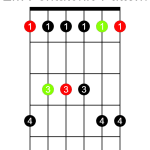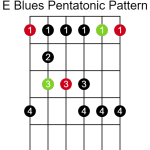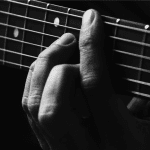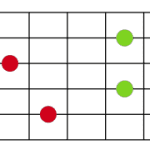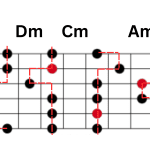In Western music, the humble major scale is pretty much the building block of music. Yes, there are musical modes out there, but they’re better understood through major scales. Major scales form the key of a song, and ultimately, chords are built on degrees of a scale. While there are a ton of different scales you can play on guitar, knowing and understanding the major scale is a fairly important one!
That being said, before jumping in and learning the major scale patterns, I would suggest you first learn the minor pentatonic scale patterns on guitar. After that, learn the major pentatonic scale patterns. These are simpler patterns that will help get your fingers moving over the fretboard. Once you’re comfortable with those, come back and learn major scales. Major scales (or any full scales for that matter) aren’t inherently harder or more complex, there are just more notes. Get comfortable with the basics first, then go more complex.
Take me to the major scale patterns
What Is A Major Scale
A major scale consists of seven notes before returning back to the root one octave higher.
Put simply the note that separates a major scale from a minor scale is the difference between the 3rd degree of the scale. In a major scale, the 3rd is major, while in minor scales the 3rd is minor. A major third is an interval of two full tones, while a minor third is an interval of one and a half tones (three semitones). Here’s a full lesson on finding thirds on guitar.
That’s all relatively broad, of course, but we’re talking basics here and I’m not going to go into various musical modes.
If you want to know the intervals between notes in a major scale, starting at the root go tone, tone, semitone, tone, tone, tone, then a final semitone to go back to the root. A major scale spans 11 semitones in total, before going back to the root on the 12th semitone.
But you don’t want to play scales across one string! It’s easier to play a scale across the strings on guitar. After all, you have six of them… So read on.
How To Read Scale Diagrams
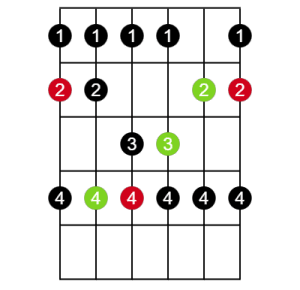

I’ve opted to show scales in a vertical diagram with the low E string on the left and the high E string on the right. I’ve seen this way be presented before, as well as other ways. This kind of diagram works for me.
To make things easier, each scale diagram shows the root in red as well as the notes from the major chord in green. You’ll also see suggested fingering in the numbers on each dot.
If you haven’t learned basic guitar chords yet, I suggest you do before learning scales. But once you learn those chords, you’ll see how those chords fit into the scale patterns. Look at the coloured dots and you can see the chord shapes there!
How To Practice Major Scales On Guitar
Literally just go up and down the scale. Keep doing this until you have the muscle memory to go up and down the scale effortlessly. These patterns should be locked in and you should be able to play them without even thinking.
Once you’re able to go that, you can then start improvising and creating riffs with the scale.
Here Are The Five Major Scale Patterns
Take me to a scale pattern
It’s best to think of scale patterns in relation to their corresponding open chord shape. So the name of the pattern doesn’t relate to what key the scale is in, it relates to the pattern you’re playing. So, for example, the E pattern is based on the E shape chord.
These patterns can be played anywhere on the guitar neck whether you play them open or way up the fretboard.
I’ve mentioned this before in relation to scales, but I’ll say it again, knowing how the chord shapes fit into the scale can be really helpful in understanding the scale pattern and remembering where you are in the scale. If you know where the root, the 3rd, and the 5th is, you can easily navigate to other degrees of the scale. This is a good skill to have for generally finding notes on the guitar.
And That’s The Major Scale Shapes
That’s the five major scale shapes for guitar.
As mentioned, practice these scales over and over again until you can play them without thinking. This may sound labourious, but there’s not replacement for practicing. Of course, you probably want to spend your guitar practice and playing time actually playing guitar songs, but if you can master these scales, you’ll become a much better player.
If you find going up and down scales a bit boring (because it can be), feel free to turn the TV on while doing it. You’re trying to create muscle memory here, so you’re welcome to multi task!
E Major Scale Pattern


The E major scale pattern isn’t a terribly difficult one to get your fingers around. There aren’t any shifts in position and the E shape chord is quite obvious in it. The only thing you may have difficulty remembering is that a lot of the scale notes happen behind the chord notes. That is for example, as mentioned the scale pattern continues to the 7th behind that first root note.
A Major Scale Pattern
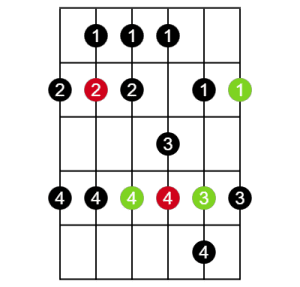

Again, it’s easy to see the chord shape within this scale.
To practice this scale, start on the root note on the 5th string with your second finger. Play up the scale, then back down the scale, passing through the root note, turn around again, and finish on the root note.
You’ll also notice that you’ll need to shift position on the 2nd string. I’ve put the suggested fingering on the diagram, which works well for just running up and down the scale. However, if you’re improvising or playing a riff in this scale shape, you may find more convenient finger positions.
D Major Scale Pattern
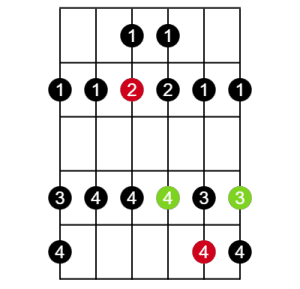

As with the other patterns, when practicing the D major scale pattern, start with the root note, this time on the 4th string. Play up the scale, then back down, going past the root and back again so you play the scale over all six strings.
G Major Scale Pattern


The G major scale pattern, on the other hand, is its own shape, not based on the E shape (mostly).
As with the A and D shape major scales, there is a position shift in this scale. I wouldn’t call it difficult, but you need to be prepared for this shift in position by using your fourth finger on the 4th string, as shown in the diagram. Other than that, if you’ve gotten comfortable with the other scale patterns, the G shape shouldn’t be too much of a challenge.
C Major Scale Pattern


There’s no shift in position for this scale pattern, so it’s pretty simple to play.
As with all the scales, make sure you start and end on a root note when practicing the scale. Go up, go down, pass through the root, and come back again so you play all six strings.
Other than that, there’s not much more advice I can give you for this chord shape!
Related posts:
